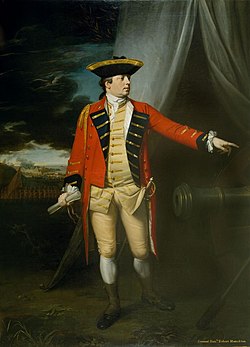Robert Monckton
Robert Monckton | |
|---|---|
Commander of Fort Lawrence Commander of British expeditionary force to Fort Beauséjour Second in Command to General James Wolfe at Quebec Commander of British forces in the southern provinces Commander of British forces capturing Martinique | |
| Battles/wars | War of the Austrian Succession
|
| Other work | MP for Pontefract Lieut Governor of Nova Scotia[1] Governor of Province of New York Governor of Berwick-upon-Tweed Governor of Portsmouth MP for Portsmouth |
| Signature | |
Early life

Robert Monckton was the second son of Elizabeth Manners and
Monckton's father died later that year and he thus inherited control of the parliamentary borough of
Monckton was called to
French and Indian War
In the winter of 1754, Governor Charles Lawrence of Nova Scotia and Massachusetts Governor William Shirley, under a general British directive, made plans to deal with French "encroachments" on the frontier of the British North American colonies. This process ultimately led to the beginning of the final French and Indian War and the onset of the Seven Years' War in North America. One of the first actions of this war was to be at Fort Beauséjour and Robert Monckton, with his intimate knowledge of the terrain and the local fortifications, was invited to spend the winter in Boston to assist in the planning process.
Fort Beauséjour
- See main article at Battle of Fort Beauséjour

In June 1755, Monckton, commanding a fleet of 31 transports and three warships carrying 270 British regular troops and 2,000 New England militia, entered
Acadian deportation
Following the capture of Fort Beauséjour, Governor Lawrence and the
Monckton was named Lieutenant Governor of
The Plains of Abraham

Early in 1759, General
As the siege wore on, General Wolfe and his three brigadiers came to dislike each other and disagreed as to how to conduct the battle plan.
The Plains of Abraham were quickly gained and the British forces marshalled into fighting ranks. The French commander of Quebec,
Monckton was relieved of his duties at Quebec on 26 October 1759 and was reassigned to New York for convalescence. He eventually recovered from his wound and, in 1760, was appointed Colonel of the
Capture of Martinique

In 1762, Monckton was given the command by
The capture of Martinique by Monckton was of tremendous strategic importance to the British war effort as it gave the British a very valuable bargaining chip in the subsequent peace negotiations. The French much desired the return of this valuable island and its sugar plantations. At the Treaty of Paris, which ended the Seven Years' War, the French willingly bargained away Canada and Acadia in return for Martinique. Voltaire at the time, famously stated that Canada was nothing more than "a few acres of snow". The capture of Martinique thus helped to disproportionately influence the course of history in North America.
Later life
Monckton returned from the Caribbean later in 1762. He was subsequently named Governor of the
Legacy
The city of Moncton, New Brunswick (near Fort Beauséjour) is named for him. As of 2016, the population of Metro Moncton (Moncton, Dieppe, and Riverview) is 144,810.
Monckton, however, remains somewhat of a controversial historical figure. He is generally reviled by the Acadian population of the Maritimes for his role in the deportation, but for the most part, Monckton was merely a subordinate following Governor Lawrence's directives. Aside from the deportation debacle, Monckton can be considered as one of the more skilled British commanders during the Seven Years' War and as a competent administrator.
Writing in 1884 about the later assessments of the historical event, noted 19th-century historian Francis Parkman concludes, "New England humanitarianism [and by implication, like-minded others to follow], melting into sentimentality at a tale of woe, has been unjust to its own. Whatever judgment may be passed on the cruel measure of wholesale expatriation, it was not put in execution till every resource of patience and persuasion had been tried in vain."
As an example of the mixed emotions surrounding Monckton's legacy, "The Un-Canadians", a 2007 article in Beaver Magazine, includes Robert Monckton in a list of people in the history of Canada who were considered by the authors contemptible: "Lieutenant-General Robert Monckton, a colonial administrator in British North America, implemented the exile of the Acadians in 1755."[3]
See also
References
- ^ "An Historical Account of the Proceedings of the last Session of the British Parliament". The Universal Magazine of Knowledge and Pleasure. 23: 170. October 1758.
- ^ a b c d "Biography of General Robert Monckton". militaryheritage.com.
- ^ The Un-Canadians Beaver;Aug/Sep2007, Vol. 87 Issue 4, p30
- Steele, I. K. (1979). "Monckton, Robert". In Halpenny, Francess G (ed.). Dictionary of Canadian Biography. Vol. IV (1771–1800) (online ed.). University of Toronto Press.
